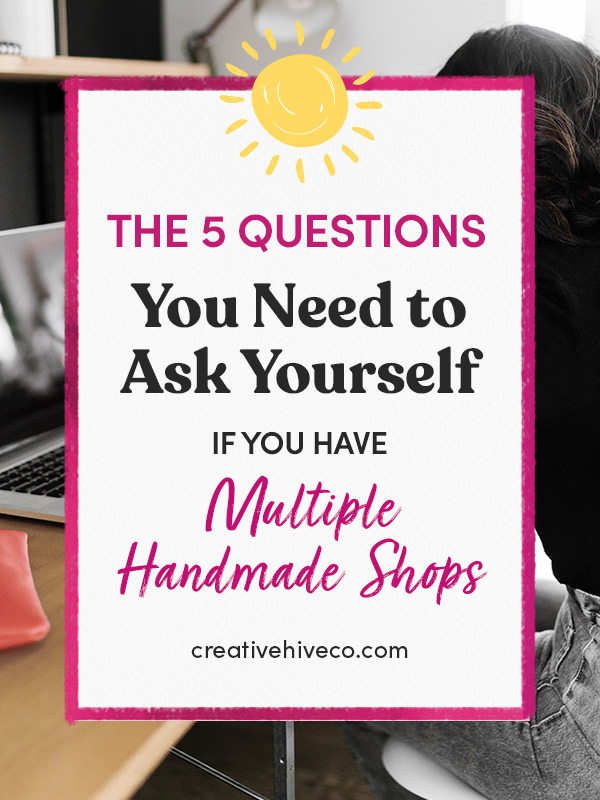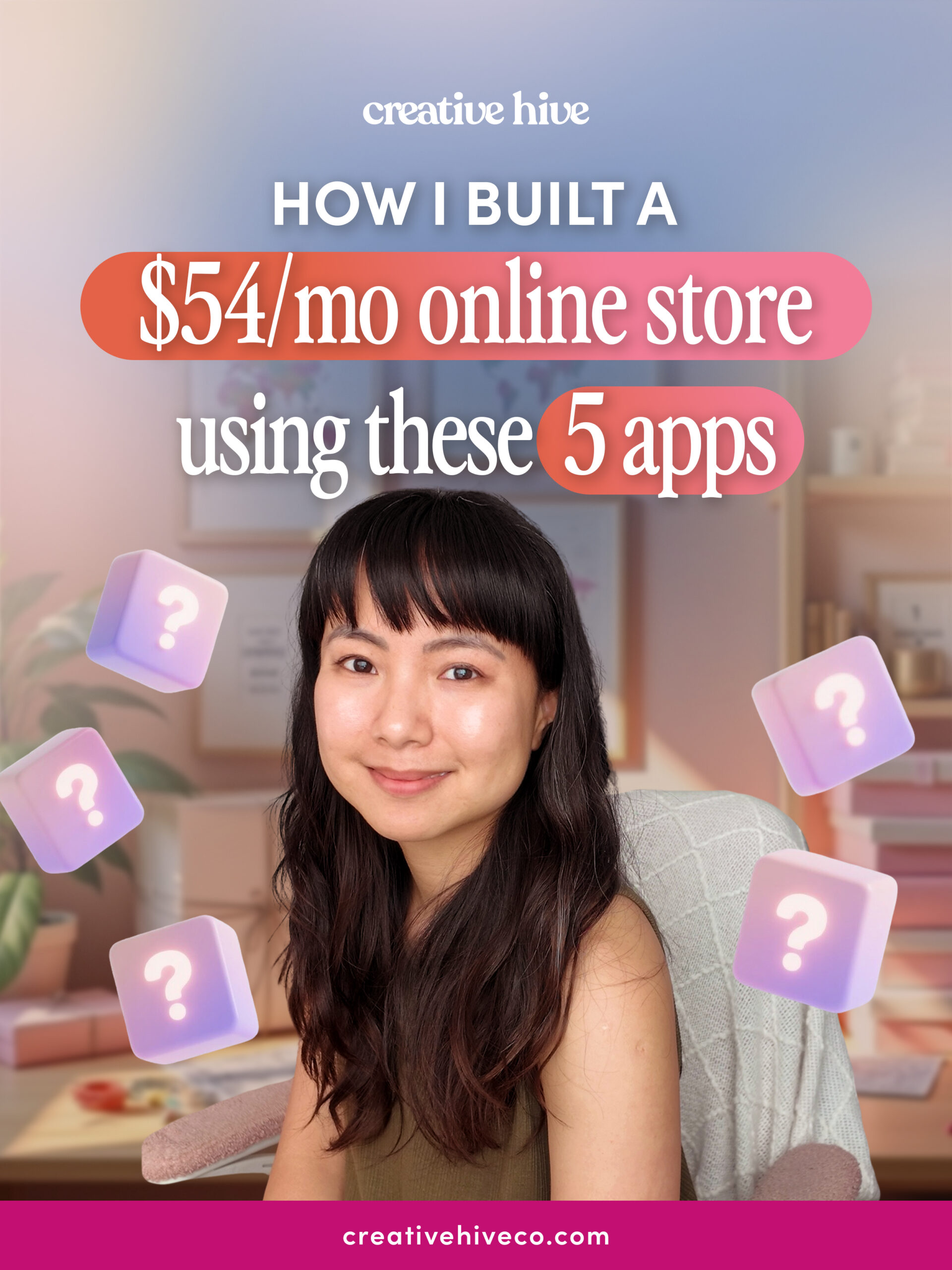The 5 Questions You Need to Ask Yourself if You have Multiple Handmade Shops
I want to help you build a sustainable, profitable handmade business that makes you consistent income and sales. I only ever teach or recommend marketing, social media, pricing, production and branding tips that I’ve personally used successfully in my own 7-figure handmade businesses.
I'm Mei, from Los Angeles!
Read More
Popular Posts You'll Love
Looking for something?
Categories
starting a business
get more traffic
running a business
make more sales
branding
growing a business
mindset & productivity
podcasts
pricing & money
product photography
reviews
selling on etsy
selling on amazon
social media
selling wholesale
- Facebook0
- Twitter0
- Pinterest20
- 20shares
If you’ve already got one business and you’re thinking about starting a new one, you might be asking yourself if you should keep everything under one umbrella or start the new business from scratch.
Keep reading to get the 5 questions that will help you make the right decision in a snap!
I’ve been running a handmade business for over 14 years, and I’ve been coaching other small business owners on how to run their creative business for half of that time.
And I run two completely different businesses, but if we’re really counting, we technically have six different businesses in our household!
They each get their own Schedule C when it’s tax time. When you have ideas for multiple businesses like that, you have to decide whether or not you’re going to keep everything under the same umbrella, or split them up and keep them separate.
Today I’m going to give you five questions to ask yourself to make that decision a whole lot easier.
1. Have you fallen out of love with your first business?
Don’t be afraid to get totally honest here. It can be hard to admit the truth when you’ve put years of your life into it.
If you’re getting really excited about your new company, think about whether you’re truly energized to run two companies or do you actually deep down want to pivot your first company to do this new idea?
There is a huge difference between pivoting and starting an entirely new business and that is something that you need to get clear about.
Before you go too deep, this is a great time to think hard about your first business. Have you really taken the time to make your first business as smooth and as efficient as it can be?
For example, my business, Tiny Hands, sells polymer clay, scented food jewelry. My branding is so spot on and my marketing and sales systems run so smoothly that it doesn’t matter what second business idea I come up with, it would be confusing to run it under the Tiny Hands umbrella.
If you’re able to add in your second business idea without even blinking into your first company, this could be a sign that your first company isn’t niched enough. You may need to go back and do some work there.
That’s for you to decide.
2. Is the audience and branding largely overlapping?
Will a person, who’s an avid fan of your first business still be interested in your second one?
This is where it’s important to really think about your ideal customer.
Don’t cheat.
I know it’s really easy to say, “oh, I sell pet portraits and obviously those customers would like my pottery business too because I have such a cool, modern aesthetic that fits both of those.”
I want you to answer your branding and ideal customer questions for both of the companies.
- Have you thought about what colors will resonate best?
- What type of copy?
- How much do they overlap?
Think about that ideal customer and then step back and look at them once you’ve done those exercises.
If you genuinely have two companies that have overlapping audiences and aesthetics, then there are paths for you moving forward to keep the same social media profiles and website unifying them.
If you have done this work and you think, “hmm, the demographics actually are a bit different. If I’m doing them both justice and serving them best,” then that’s your clue that they might be better off being split off into two separate profiles.
In the early days of Creative Hive, I thought I had some people in my Tiny Hands audience who were interested to learn how to start their own handmade business. So the very first time I tried to sell some coaching sessions, I put that listing up on my Tiny Hands website.
Can you imagine what happened? No one bought it!!!
The overlap of audience between the two businesses either wasn’t strong enough or it just wasn’t there at all, which is why both Tiny Hands and Creative Hive exist as separate businesses.
I’m so glad for this because both of them can stand on their own two feet independently and they both require very different systems of operations and teams to keep them running.
3. Do the products of both of these companies form some kind of continuum that would be reasonably packaged under one umbrella?
Does adding the second company make you a stronger competitor than your first company standing alone, or does it look like a mess?
For example, say you are a florist and you now have a passion for photography and you want to make a second photography business. You have to ask yourself, do these fit together or should they be separate?
Well, if you were doing wedding florals before and now you want to have a wedding photography company, you can put those under one umbrella and it would make sense to the customer. You could brand it as a one-stop wedding shop for people in your local area.
That combination makes you a stronger competitor than you would have been before just as a florist.
However, if the two companies when put together look like a mismatch or it’s not gaining you followers in a way that makes sense for both businesses, then that’s a sign that they should not be put together.
If you were a florist and a dog walker, maybe those two can’t reasonably be put together.
4. Is the new company best served by leveraging the resources of your first one?
Or is it going to suffer from the baggage?
I think we all think that we can leverage our existing followers on social media to hop on the bandwagon of our new company, and that’s not necessarily the case.
First off, by increasing the size of your company you run the risk of becoming too general.
Which basically means, you’ll be losing out on that niche advantage where you’re known as the shop that does realistic super cute scented food jewelry.
Imagine if I started selling stickers, stationery, and fashion accessories like bags, hair ties, and shoes. My business would be more general and no longer as niched down.
As a side effect, I would no longer be as memorable to other people.
If people can’t remember my business, I’m not going to make any sales. A good rule of thumb is simple sells.
While there are certainly gains from having a larger social media account in terms of attracting new followers because you have all this social proof, you also will experience less engagement as your account gets larger and older.
A lot of the old followers you got from five years ago probably don’t even use the same Instagram account anymore.
It’s likely that by starting a new account that’s directly targeting your ideal customers of that second company, that you will get better results overall.
So think about whether you’re holding the second company back by forcing them to be together.
5. Are you trying to keep your two companies together because that’s the best thing for both of the companies or because it feels like so much work to go through setting up the second business properly?
This one might be the hardest in terms of really being honest with yourself, but I have to put it out there because we’ve all been there, myself included.
I’m not going to lie, setting up a new business can be annoying.
You have to:
- Start a new website
- Get a new domain name
- Get new social media profiles
- Put up the images
- Get new photography
- Get a new logo
- Get new branding
- And do two times the marketing
It’s a lot of work!
But if you’re not feeling like you have the energy to invest in setting up a second company, you have to really ask yourself whether you have the energy to run a second company.
Trust me, it is way more painful to split two companies into separate newsletter subscribers, separate websites, separate SEO after you’ve glommed them together than it is to do it right from the start.
Do the thinking now to avoid some pain later!
Bonus Question!
Now, because you stayed to the end, I have a bonus question for you to ask yourself.
* Is your first business already automated and doing well?
This is a tie in to question number five. It’s a lot of work to start a completely new business from scratch. I think it’s totally feasible to start a new business, if your existing business is already doing well, you’re happy with it, you’ve got automated systems and things just flow smoothly.
You’re not trading time for dollars with that business, meaning you’re not working IN the business, you’re working on it.
So a good way to check is if you go on vacation for a month, can your first business continue operating and making sales without you?
If the answer is yes, then you’re probably ready and able to start a whole new other business.
I hope you found these tips helpful.
If you enjoyed this post or have any questions, leave a comment below. Don’t forget to check out my YouTube channel for more tips and inside secrets!

Leave a Comment
Liked this article? Share it!
Unlock a Profitable Handmade Business
in Just 12 Weeks Without Using Etsy
or Social Media
FREE WORKSHOP
This workshop is for anyone who makes and sells a handmade or physical product, including jewelry designers, artists, paper designers, bath & body product makers and more!
What You'll Discover
The #1 mistake people make with Etsy & social media that causes shops to FLOP
The secret to making it with your handmade shop so it's no longer just a hobby
How to make sales in your handmade shop with ease so you can finally get to 6-figures
TAKE ME THERE
Your email address will not be published. Required fields are marked *
Leave a Reply Cancel reply
About
Blog
A Sale A Day
Student Login
Free Class
Contact
Terms
Become A Student
Watch On YouTube
Student Reviews
See My Handmade Shop!




I am very impressed with your article. Like you said when you delete a result, run 3 it will be pushed from the left participant column to the right result column. I like it very much.
When you’re managing multiple handmade shops, asking yourself five key questions can be like solving a mystery in FNAF. Each question helps you tweak and optimize your operations, ensuring everything runs smoothly and there are no unexpected surprises.